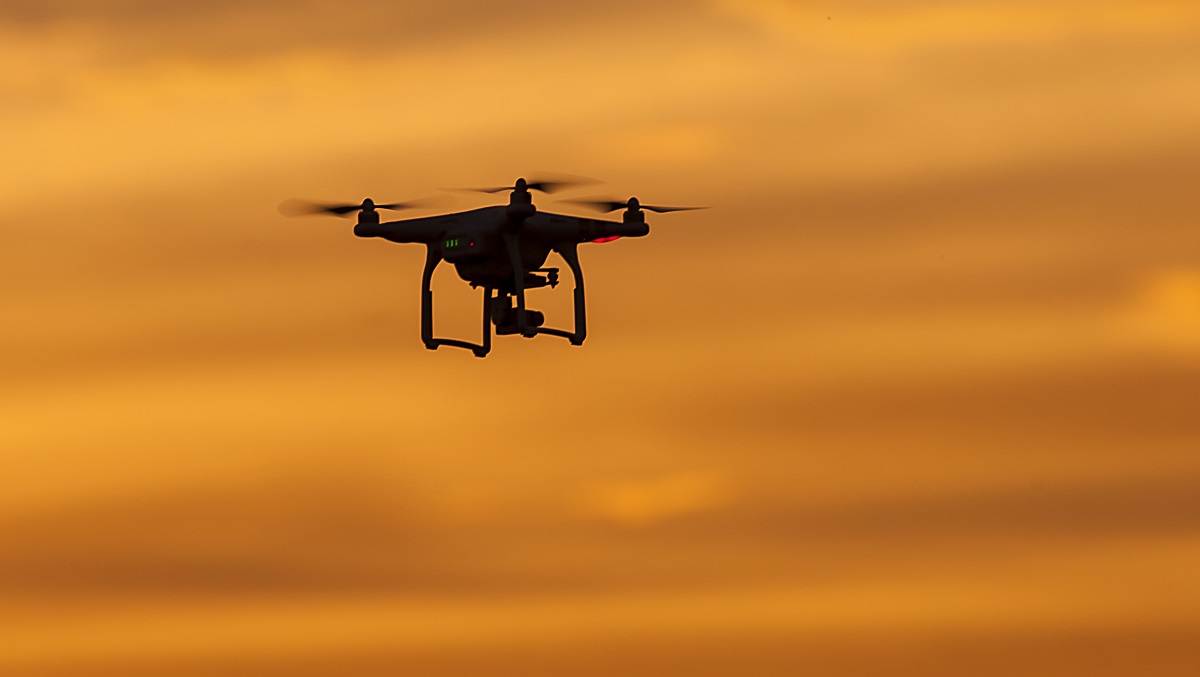
We urge the militaries of the United States and other democratic states to prepare to both counter drones and harness them during future conflict.
The Russia-Ukraine and Gaza wars have illustrated that simple drones are no longer a nuisance from terrorists that can be ignored or even easily countered. It has become a weapon of choice for standing armies, with Ukraine, Russia, and Israel extensively incorporating tactical drones into their military arsenals. Because international security challenges are increasing in quantity—stemming from more, diverse actors operating from the gray zone to total war—and modern warfare is changing in quality—becoming more transparent, lethal, fast-paced, and multi-domain—more states will emulate the use of tactical drones in Ukraine. We urge the militaries of the United States and other democratic nations to prepare to both counter drones and harness them during future conflict.
Yet what branch of service should take the lead in preparing the military to contend with these burgeoning challenges and opportunities? For operations in the air littoral, it has been hazy whether this should fall to air or land forces. Although many people associate unmanned aerial systems (UAS) with air forces, ground forces have been the most exposed to small drones and are the most likely to benefit from their use in battle theaters. Consequently, armies are currently the most incentivized and poised to develop atactical drone fleet that would neither replace nor compete with strategic models.
The Original Commercial Drone Threat
The U.S. military and its allies have contended with terrorist-operated commercial drones for over a decade. During the Afghanistan War, the Taliban maintained frequent surveillance of American troops, primarily with Chinese-manufactured DJI drones. The situation became more precarious in Iraq, with several “special groups” using commercial, military-grade, and hybrid UAS to surveil and target U.S. and coalition forces. Indeed, some penetrated heavily armed and air-protected U.S. bases.
The Islamic State hounded coalition forces with commercial drones during its heyday. U.S. Special Operations Command commander General Tony Thomas called the Islamic States’ use of UAS “2016’s most daunting problem.” In 2017, the group was prolifically conducting attacks estimated between 60 and 100 each month, using UAS to drop munitions, designate sniper fire, coordinate fighters, and maximize chaos.. Many involved sustained quadcopter clusters appearing as swarms.
Four years later, U.S. Central Command commander General Kenneth McKenzie identified terrorist-operated drones as one of his highest priorities to counter. This followed frequent attacks in Syria featuring simple drones dropping munitions to cripple advanced aircraft and causing casualties. This trend has only increased as Hamas integrated small UAS into its October assault on Israel to break through border defenses, Houthi forces and Iraqi paramilitary groups have continued to threaten and attack military and commercial targets in the area using aerial and aquatic drones from thousands of kilometers away, and drone-entrepreneur Hezbollah looms in Lebanon. The latter has conducted hundreds of drone attacks against intelligence installations, air defense assets, and both soldiers and civilians. While this does not elevate terrorists to equate in capabilities with militaries, it does make them more dangerous and poses a meaningful threat, especially to weaker or overextended states.
Several other nations and institutions have recognized these risks in conflict zones and home fronts. NATO, the Global Counterterrorism Forum, the UNSC Counter-Terrorism Committee, and INTERPOL are advancing frameworks to conduct research, develop best practices, and mitigate emerging threats. The almost universal global response has been to counter commercial drones. With the commendable exception of more structural “left of launch” approaches, most of these are reactionary defensive efforts. From jets and missiles, geofences and no-fly zones, radar and jammers, to nets and directed energy devices, states’ tactical knee-jerk reaction to terrorist consumer drones has been to turn to the counter-UAS industry.
A New Commercial Drone Era
Threats stemming from state drones have been another story. Military-grade platforms offer much higher capacity (range, altitude, payload, endurance, precision) and much lower risk (operator and data link security). Although there are several drivers of adoption in the political economy of drones, initial scholarly takes suggested that states that can afford to add UAS to their repertoires have little interest in the “toy” quadcopters that constitute the most common choice for terrorists.
Or so many thought. According to the “drone ages” framework, the first era involved state threats, the second malicious nonstate threats enabled by commercial technologies, and the third unfolding age features nonstate threats upgraded by state support and ever advancing technology and automation. An inverse trend is afoot, and the current wars are an inflection point.
Three formidable states with advanced drone fleets have intensively incorporated commercial UAS on the battlefield for reconnaissance, target designation, propaganda, psychological pressure, and attack. Ukraine initiated this trend, issuing calls for “dronations” to build an “army of drones.” Keeping its exquisite UAS arsenal for strategic missions, it quickly amassed a “mosquito air force” of commercial models to tactically resource ground troops. By the summer of 2022, this innovation proved so effective that Russian units on the defensive made targeting Ukrainian drone operators their top priority and when on the offensive began substantial efforts to emulate Ukrainian use. Most recently, Ukraine has gone as far as establishing an Unmanned Systems Force in its military taxonomy. Separately, Israel rapidly diffused small drones and nascent tactics, techniques, and procedures in the Gaza conflict to more effectively fight in built-up battlespaces.
Why did these powerful states with heavy drones and advanced air capabilities resort to cheap commercial analogs? For one, because they are cheap. To democratize small drones to ground units for tactical deployment, they must be affordable. To deploy them often and daringly on the front lines for multiple mission types, they must be dispensable. Some analysts and users conceptualize simple drones as ammunition, expended when needed and casings left behind without batting an eye. Not every field commander can have a Turkish-manufactured TB-2 Bayraktar in their backpack, but a foldable DJI Mavic is feasible.
Second, these warring nations are tapping commercial drones because they are commercial. Rapid procurement and replacement are not reliant on bureaucratic processes and production limitations. The operation of commercial drones does not require extensive training or expansive, proprietary infrastructure. They are easier to adapt with off-the-shelf or jury-rigged, after-market capabilities. From manufacturing to modifications to maintenance, these processes that are usually dense and cloaked in military channels are outsourced to a wide market that is difficult to disrupt.
We emphasize that commercial UAS are effective tools at the tactical and sometimes operational levels. We do not assert that they promote strategic advantages or outcomes.
Finally, troops value them because they are analogs of military airpower. They grant foot soldiers on-demand area reconnaissance from ideal vantage points, greater autonomy and mobility on dynamic battlefields, fire correction with conventional weapons, and improved strike abilities on protected positions. Especially as commercial models become more sophisticated, they perform lower-level tasks comparably to military models at much lower cost. In fact, these militaries have developed interest in toy quadcopters for the same reasons as terrorists: they are affordable, accessible, and adaptable for multiple combat uses.
We emphasize that commercial UAS are effective tools at the tactical and sometimes operational levels. We do not assert that they promote strategic advantages or outcomes. Indeed, drones alone cannot end the Ukraine War, and Israel would have prevailed against Hamas without tactical UAS. Rather, they are a force multiplier for foot soldiers.
Assimilating Tactical Drones
Some nations have already begun building the acquisition, training, and integration architectures to support assimilation. Before the Hamas invasion, Israel initiated a staged plan for implementation at the platoon level, citing “a lesson learned from the war in Ukraine.” The Gaza conflict hurtled it forward in time and across units. Several U.S. Army entities—the Army Maneuver Battle Lab, Army Test and Evaluation Command, Soldier UAS Product Office, and Short-range Reconnaissance Program—have been collaborating to develop, test, and field small UAS with some units receiving quadcopters at the end of 2022. The U.S. Army’s future tactical UAS effort initially anticipated fielding its first units in 2026, but astute practitioners have prioritized and hastened this process. The Replicator program launched in September 2023 entails military modifications to thousands of commercial drones, and the Army announced in March that it will distribute small drones to infantry units for more experimentation. Wherever partner militaries are on the small UAS assimilation curve, we offer five considerations.
Identify an ideal drone mix
In the Ukraine War, some military leaders advocate for two levels of tactical drones. Ultracheap, expendable models can be mass-produced and used more liberally. More advanced models produced at a more constrained scale can be assigned to experienced or specialized UAS operators. The United States currently has seven small UAS programs, exploring reconnaissance drones, tethered UAS, and first-person view systems. Within this scope, there is a trade-off between specialization and standardization. This also applies to the systems onboard the launched effects, from avionics to armaments. And although we are focusing on unmanned aerial systems, ground and aquatic drones are growing in salience and decision-makers should consider the full ecology of drones in procurement decisions.
Find a sourcing sweet spot
Armies must develop acquisition pathways that converse and pace with but are not entirely equivalent to the commercial drone industry. We do not advocate for Amazon or Chinese drones with national stickers glued on. Like any platform, tactical drones must be standardized to enable cross-organization, muscle memory use under pressure, and predictable performance. Cultivating a handful of engineering and manufacturing partnerships that deliver this reliability at scale will enable 1) sensible updates as commercial sophistication advances and 2) standardization of systems, quality, and output. Perhaps this comprises a small suite of UAS options or a single modular platform.
Balance security and sustainability
The allure of commercial drones is their low cost, yet this comes with tradeoffs in risk and capacity. Commercial UAS have weaker datalink security. Additionally, their shorter ranges require operators to be closer to front lines or targets. A final security challenge involves protecting sensitive information when a small drone is downed and recoverable by an enemy. In developing tactical UAS, partners must identify reliable, resilient methods to address these issues in contested digital and information spaces. Yet any solution must be and remain affordable. Drones procured in the Replicator initiative, for instance, are approximately five times as expensive as commercial off-the-shelf models due to the military specifications and AI software kits designated. This might be sustainable, but leaders must identify at what degree of distribution across units and if this meets the needs of modern warfighters.
Foster responsible enterprising
Squad drones cannot be so expensive that military brass punishes their loss in theater and operators fear losing them enough to fear using them. Yet neither should small-unit commanders and operators be reckless or flippant with these tools with the expectation that another will be unquestionably assigned. Leadership must strike another balance between empowering operators to field drones boldly and disciplining conscientious stewardship.
Implement a staged rollout
The impetus and tactical value of small UAS has already been demonstrated by violent nonstate actors as well as state militaries. Rather than awaiting an urgent external shock or direct threat to cajole ad hoc or stopgap efforts, defense officials should promote more pilot programs with pointed, representative populations of army units to identify best practices, platforms, and contingency plans in different tactical configurations and settings. This is more than an acquisition issue. Assimilation necessitates that small UAS be fully understood, absorbed, and integrated at their operative levels. Reflecting on the Russian experience of adapting small drones, one U.S. Army officer working in capability integration remarked “how easy is it to change doctrine? Kind of a tectonic, glacial process, right?” Nonetheless, mercurial modern warfare demands it. It will be an iterative, two-way process. Acquiring and assigning tactical UAS is a top-down decision, but experimenting and assimilating them must be bottom-up followed by a top-down codification in doctrine.
Mixed aerial arsenals stratified for strategic and tactical missions constitute a clear requirement for state militaries. Recent battle experiences in Ukraine and Gaza demonstrate the utility of tactical UAS for modern warfare, providing a multiuse force multiplier to foot soldiers in myriad battle environments. We urge proactive efforts to acquire, innovate, and assimilate commercial and militarily enhanced small drones to provide ground forces with an organic capability in the air littoral. The U.S. and its partners must not miss this moment to prepare well for the next war.
Kerry Chávez, PhD, is an assistant professor in the Military & Strategic Studies Department at the U.S. Air Force Academy. She is also a nonresident research fellow with the Institute for Global Affairs, a two-time nonresident research fellow with the Modern War Institute at West Point, and an advisor for Project Air and Space Power at the Irregular Warfare Initiative. Her research focusing on the politics, strategies, and technologies of modern conflict and security has been published in several venues. You can find her work here.
Ori Swed, PhD, is an associate professor in the Sociology, Anthropology, and Social Work Department and director of the Peace, War, & Social Conflict Laboratory at Texas Tech University. His scholarship on nonstate actors in conflict settings and technology and society has been featured in multiple peer-reviewed journals and his own edited volume. He also gained 12 years of field experience with the Israel Defense Force as a special forces operative and reserve captain, and as a private security contractor. You can find his work here.
The views expressed in this article are those of the author and do not necessarily reflect those of the U.S. Air Force Academy, U.S. Army War College, U.S. Air Force, U.S. Army, or the Department of Defense.
Photo Description: Commercially available quadcopter drone.
Photo Credit: Greg Clarke via WikiMediaCommons




